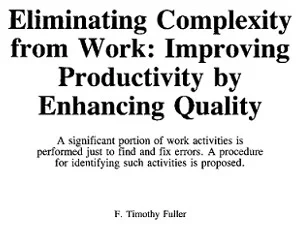Eliminating complexity from work: Tim Fuller’s insights from the 1980s
Several posts ago (Deming's chain reaction), I cited Tim Fuller’s 1985 article, “Eliminating Complexity from Work: Improving Productivity by Enhancing Quality” (National Productivity Review, 4, 327-344, Autumn 1985 issue), available at your local research library or on-line here, if you pay John Wiley a fee.
In this paper, Tim described his seminal experiences working for Hewlett-Packard in the early 1980’s, applying improvement principles outlined by W. Edwards Deming and coached by an early Deming acolyte, Dr. Perry Gluckman. From direct observation, Tim concluded that most people spent most of their time in unproductive work in both electronic assembly and office operations.
Tim offered a quick test to determine where one would find opportunity to improve operations: “The more complexity in an area, the more quickly and easily significant improvements can be made.”
Tim continues: “Often, one can make a rough estimate of the level of complexity in an operation by just walking around the work area and making visual observations of certain conditions.”
Good advice, go see!
But you have to know what to look for, to be an educated observer, not just a tourist passing through an exotic destination.
Tim guides you on what to look for in the workplace; it's worth quoting the article at length on this point:
"Seven conditions indicating a high level of complexity, and seven corresponding conditions indicating a low level, are listed below:
Indicators of high complexity:
1. Lots of work-in process materials. Many shelves in the work area to hold material.
2. Many people walking from place to place, standing in a line waiting for something, standing idle.
3. Work areas that are in disarray. Dusty boxes on the floors, bookcases full of dusty binders, and desks and walls covered with little scraps of paper serving as reminder notes.
4. People who can give only a brief, vague explanation of what they are working on and why it is important.
5. Humorous signs taped to the walls that say things like, “You want it when? Ha! Ha!” or “A clean desk is a sign of a sick mind.”
6. In office areas, piles of processed and unprocessed documents stored in the work area.
7. Supervisors and managers pacing around the area trying to find out what’s going on, ascertain who made a critical mistake, and expedite late orders.
Indicators of low complexity:
1. A small amount of work-in-process material. Few shelves in the work area to hold material.
2. Few people walking around carrying materials. Most people working at a steady, relaxed pace. No one waiting in line at copy machines, office supplies, stores.
3. Work areas that are neat. Everything in a department has a place and a use. People using time management systems instead of scraps of paper. Desk tops containing only what the person is working on at the time.
4. People on the production floor or in an office area who can give complete descriptions of what they do, why they do it, who their customers are, and what’s important to those customers.
5. The most common item displayed on department walls are monthly performance graphics, daily control charts of defects, Pareto charts of defects and problems.
6. In office areas all documents are received, processed, and filed. In baskets are clean.
7. Supervisors and managers who are relaxed, walking around the area talking with employees, asking them what they are working on, and looking for ways to make their employees’ jobs easier and more satisfying.”
Anyone who has tried to improve organization performance will find nothing new or surprising in Tim’s guidelines. Students of the Toyota Production System will naturally substitute “waste” for “complexity”.
Nevertheless, Tim’s descriptions of a low complexity operation are simple to understand and in common English, if you allow for the modest technical references to control and Pareto charts.
Try Tim's indicators along with your favorite waste checklist the next time you observe a workplace.
Historical note: While Shigeo Shingo’s study of the Toyota Production System first appeared in English in 1981 (subsequently re-ranslated in 1989) few people in the U.S. had much knowledge or appreciation for the Toyota Production System at the time Tim conducted his studies. Toyota and GM did not open their joint-venture assembly plant in Fremont, California until 1984.














